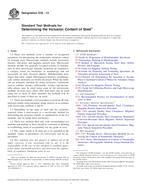We need your consent to use the individual data so that you can see information about your interests, among other things. Click "OK" to give your consent.
ASTM E3-11
Standard Guide for Preparation of Metallographic Specimens
STANDARD published on 1.5.2011
The information about the standard:
Designation standards: ASTM E3-11
Note: WITHDRAWN
Publication date standards: 1.5.2011
SKU: NS-46334
The number of pages: 12
Approximate weight : 36 g (0.08 lbs)
Country: American technical standard
Category: Technical standards ASTM
The category - similar standards:
Annotation of standard text ASTM E3-11 :
Keywords:
alloys, grinding, metallography, metals, mounting, polishing, sectioning, specimen preparation (metallographic), Specimen preparation (for testing)--metals/alloys, Structural metals/alloys, Cleaning agents/processes, Electropolishing, Etching (materials/process), Grinding materials/operations, Inclusions--metals/alloys, Metallographic analysis/inspection, Metallurgical materials/applications, Metals and metallic materials--inclusion rating, Microscopic examination--metals/alloys
Additional information
| Significance and Use | ||||||||||||||||||||
|
Microstructures have a strong influence on the properties and successful application of metals and alloys. Determination and control of microstructure requires the use of metallographic examination. Many specifications contain a requirement regarding microstructure; hence, a major use for metallographic examination is inspection to ensure that the requirement is met. Other major uses for metallographic examination are in failure analysis, and in research and development. Proper choice of specimen location and orientation will minimize the number of specimens required and simplify their interpretation. It is easy to take too few specimens for study, but it is seldom that too many are studied. |
||||||||||||||||||||
| 1. Scope | ||||||||||||||||||||
|
1.1 The primary objective of metallographic examinations is to reveal the constituents and structure of metals and their alloys by means of a light optical or scanning electron microscope. In special cases, the objective of the examination may require the development of less detail than in other cases but, under nearly all conditions, the proper selection and preparation of the specimen is of major importance. Because of the diversity in available equipment and the wide variety of problems encountered, the following text presents for the guidance of the metallographer only those practices which experience has shown are generally satisfactory; it cannot and does not describe the variations in technique required to solve individual specimen preparation problems. Note 1—For a more extensive description of various metallographic techniques, refer to Samuels, L. E., Metallographic Polishing by Mechanical Methods, American Society for Metals (ASM) Metals Park, OH, 3rd Ed., 1982; Petzow, G., Metallographic Etching, ASM, 1978; and VanderVoort, G., Metallography: Principles and Practice, McGraw Hill, NY, 2nd Ed., 1999. 1.2 This standard does not purport to address all of the safety concerns, if any, associated with its use. It is the responsibility of the user of this standard to establish appropriate safety and health practices and determine the applicability of regulatory limitations prior to use. |
||||||||||||||||||||
| 2. Referenced Documents | ||||||||||||||||||||
|
Similar standards:
Historical
1.6.2013
Historical
1.5.2007
Historical
1.6.2013
Historical
1.5.2013
Historical
1.10.2011
Historical
1.10.2009
We recommend:
Technical standards updating
Do you want to make sure you use only the valid technical standards?
We can offer you a solution which will provide you a monthly overview concerning the updating of standards which you use.
Would you like to know more? Look at this page.



 ASTM E340-13
ASTM E340-13 ASTM E407-07e1
ASTM E407-07e1 ASTM E433-71(2013)..
ASTM E433-71(2013).. ASTM E45-13
ASTM E45-13 ASTM E562-11
ASTM E562-11 ASTM E7-03(2009)..
ASTM E7-03(2009)..
 Cookies
Cookies
